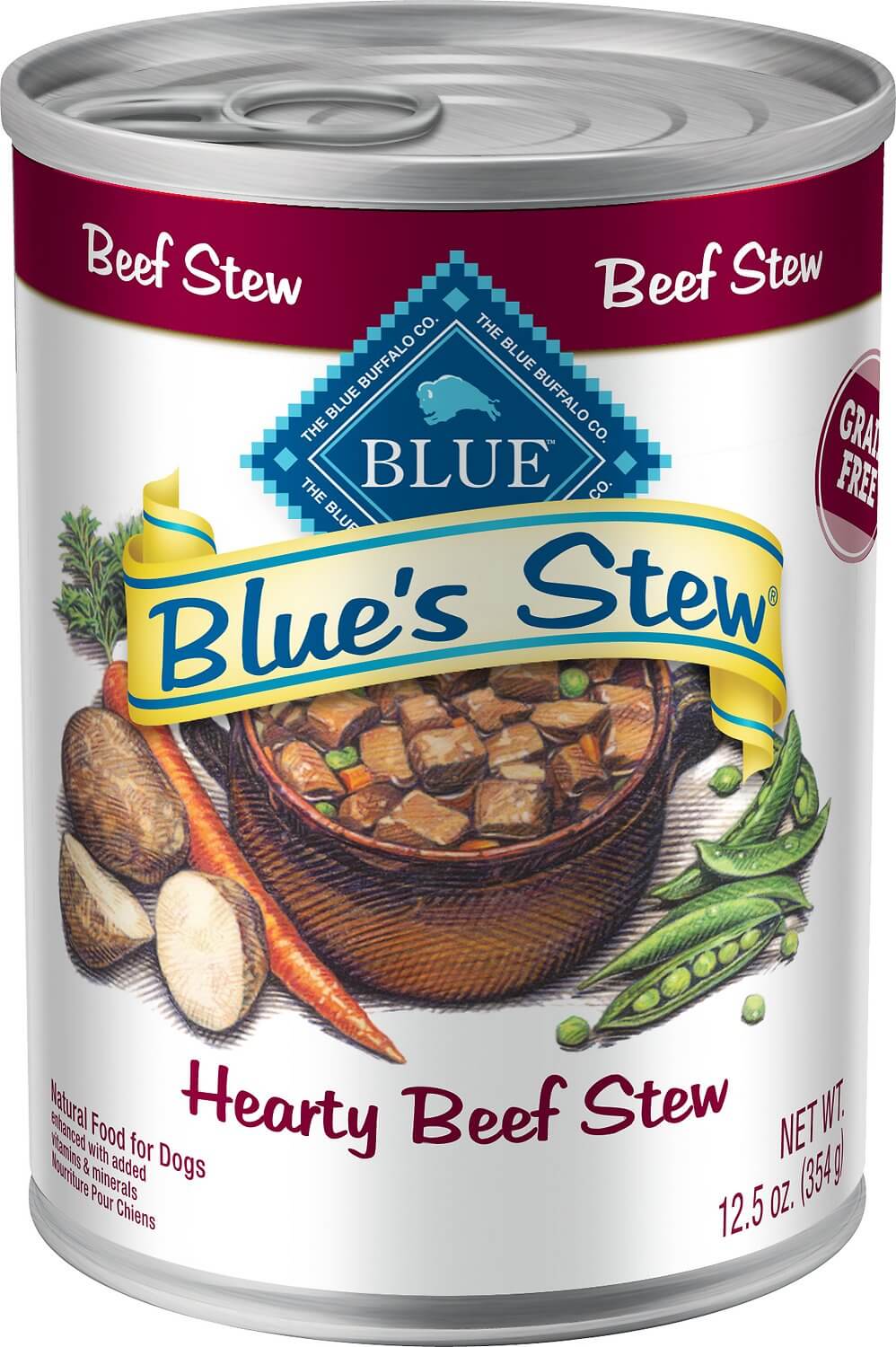
DogFoodAdvisor is reader supported See how
All reviews are 100% impartial but if you buy using links on this page, we may earn a referral fee.
Our Verdict
Blue Buffalo Blue’s Stew Can product range is made up of three recipes with ratings varying from 4.5 to 5 stars. The average rating of the whole range is 5 stars.
The table below shows each recipe in this range including our rating and the AAFCO nutrient profile: Growth (Puppy), Maintenance (adult), All Life Stages, Supplemental or Unspecified.
| Product line | Rating | AAFCO |
|---|---|---|
| Blue Buffalo Blue's Stew Hearty Beef Stew | 5 | M |
| Blue Buffalo Blue's Stew Country Chicken Stew | 5 | M |
| Blue Buffalo Blue's Stew Hunter's Stew | 5 | M |
Recipe and Label Analysis
Blue Buffalo Blue’s Stew Hearty Beef Stew was selected to represent the other products in the line for detailed recipe and nutrient analysis.
Blue Buffalo Blue's Stew Hearty Beef Stew
Estimated Dry Matter Nutrient Content
Protein
Fat
CarbsCarbohydrates
Beef, beef broth, water, beef liver, dried egg product, chicken, peas, carrots, potatoes, potato starch, guar gum, calcium carbonate, salt, sodium phosphate, caramel color, potassium chloride, natural flavor, choline chloride, zinc amino acid chelate, iron amino acid chelate, vitamin E supplement, copper amino acid chelate, manganese amino acid chelate, sodium selenite, thiamine mononitrate (vitamin B1), cobalt amino acid chelate, niacin supplement (vitamin B3), calcium pantothenate (vitamin B5), vitamin A supplement, riboflavin supplement (vitamin B2), biotin (vitamin B7), vitamin B12 supplement, potassium iodide, pyridoxine hydrochloride (vitamin B6), vitamin D3 supplement, folic acid (vitamin B9)
Fiber (estimated dry matter content) = 1%
Red denotes any controversial items
| Estimated Nutrient Content | |||
|---|---|---|---|
| Method | Protein | Fat | Carbs |
| Guaranteed Analysis | 8% | 4% | NA |
| Dry Matter Basis | 44% | 19% | 28% |
| Calorie Weighted Basis | 37% | 39% | 24% |
Ingredients Analysis
The first ingredient in this dog food is beef. Beef is defined as “the clean flesh derived from slaughtered cattle” and includes skeletal muscle or the muscle tissues of the tongue, diaphragm, heart or esophagus.1
Beef is naturally rich in all 10 essential amino acids required by a dog to sustain life.
The second ingredient is beef broth. Broths are of only modest nutritional value. Yet because they add both flavor and moisture to a dog food, they are a common addition component in many canned products.
The third ingredient is water, which adds nothing but moisture to this food. Water is a routine finding in most canned dog foods.
The next ingredient includes beef liver. This is an organ meat sourced from a named animal and thus considered a beneficial component.
The fifth ingredient is dried egg product, a dehydrated form of shell-free eggs. Quality can vary significantly. Lower grade egg product can even come from commercial hatcheries – from eggs that have failed to hatch.
In any case, eggs are easy to digest and have an exceptionally high biological value.
The sixth ingredient is chicken. Chicken is considered “the clean combination of flesh and skin… derived from the parts or whole carcasses of chicken”.2
Chicken is naturally rich in the 10 essential amino acids required by a dog to sustain life.
The next ingredient includes peas, which are a quality source of carbohydrates. And like all legumes, they’re rich in natural fiber.
However, peas contain about 25% protein, a factor that must be considered when judging the meat content of this dog food.
The eighth ingredient lists carrots. Carrots are rich in beta-carotene, minerals and dietary fiber.
The ninth ingredient is potato. Potatoes can be considered a gluten-free source of digestible carbohydrates. Yet with the exception of perhaps their caloric content, potatoes are of only modest nutritional value to a dog.
From here, the list goes on to include a number of other items.
But to be realistic, ingredients located this far down the list (other than nutritional supplements) are not likely to affect the overall rating of this Blue Buffalo product.
With three notable exceptions…
First, caramel is a natural coloring agent made by caramelizing carbohydrates. It’s used by pet food manufacturers to impart a golden brown tint to the finished product.
However, the concentrated version of this ingredient commonly known as caramel coloring has been more recently considered controversial and found to cause cancer in laboratory animals.3
In any case, even though caramel is considered safe by the FDA, we’re always disappointed to find any added coloring in a pet food.
That’s because coloring is used to make the product more appealing to humans – not your dog. After all, do you really think your dog cares what color their food is?
Next, this food contains chelated minerals, minerals that have been chemically attached to protein. This makes them easier to absorb. Chelated minerals are usually found in better dog foods.
And lastly, this recipe includes sodium selenite, a controversial form of the mineral selenium. Sodium selenite appears to be nutritionally inferior to the more natural source of selenium found in selenium yeast.
Nutrient Analysis
Based on its ingredients alone, Blue Buffalo Blue’s Blue’s Stew Hearty Beef Stew Dog Food looks like an above-average wet product.
The dashboard displays a dry matter protein reading of 44%, a fat level of 19% and estimated carbohydrates of about 28%.
As a group, the brand features an average protein content of 43% and a mean fat level of 22%. Together, these figures suggest a carbohydrate content of 26% for the overall product line.
And a fat-to-protein ratio of about 51%.
Which means this Blue Buffalo product line contains…
Above-average protein. Near-average fat. And below-average carbs when compared to a typical wet dog food.
Even when you consider the protein-boosting effect of the peas, this looks like the profile of a canned dog food containing a significant amount of meat.
Blue Buffalo Dog Food Recall History
The following automated list (if present) includes all dog food recalls related to Blue Buffalo through April 2025.
- Blue Buffalo Dog Food Recall Event Number 2 of March 2017 (March 18, 2017)
- Blue Buffalo Dog Food Recall of March 2017 (March 3, 2017)
- Blue Buffalo Dog Food Recall of February 2017 (February 14, 2017)
- Blue Buffalo Dog Food Recall of May 2016 (May 31, 2016)
- Blue Buffalo Dog Chews Recall of November 2015 (November 25, 2015)
- Blue Buffalo Dog Food Recall (October 8, 2010)
You can view a complete list of all dog food recalls since 2009 here.
Our Rating of Blue Buffalo Blue's Stew Dog Food
Blue Buffalo Blue’s Stew is a grain-free canned dog food using a significant amount of named meats as its dominant source of animal protein, thus receiving 5 stars.
Please note certain recipes are sometimes given a higher or lower rating based upon our estimate of their total meat content and (when appropriate) their fat-to-protein ratios.
Those looking for a nice kibble from the same company may want to check out our review of Blue Buffalo Life Protection Dog Food.
Compare Blue Buffalo Blue's Stew Dog Food
How does Blue Buffalo Blue's Stew compare with The Dog Food Advisor's most recommended brands?
A Final Word
The Dog Food Advisor does not accept money, gifts, samples or other incentives in exchange for special consideration in preparing our reviews.
However, we do receive a referral fee from online retailers (like Chewy or Amazon) and from sellers of perishable pet food when readers click over to their websites from ours. This helps cover the cost of operation of our free blog. Thanks for your support.
For more information, please visit our Disclaimer and Disclosure page.







